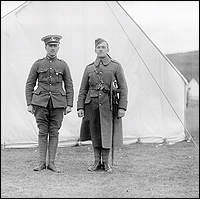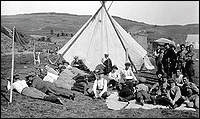Recruitment and Training 1914
When Great Britain declared war on Germany, it did so on behalf of the entire British Empire. Newfoundland, as Britain’s first Colony, was eager to make its contribution and willingly joined the war effort. At the time, there was no military organization in the colony. The military had been absent from Newfoundland since 1870.
The first step in filling this gap had been taken in 1902 by Governor Sir Cavendish Boyle when the Royal Naval Reserve of 600 men was formed. In 1907, Governor Sir Robert Bond, noting the conspicuous absence of a Newfoundland contingent in the South African War, had requested assistance from Britain in forming a volunteer reserve land force battalion. The response from Britain was that Newfoundland would have to fully finance the force, and the venture went no further.
A number of paramilitary groups had been formed in the meantime which were sponsored by the various churches. This initiative began in 1892 under the Church Lads’ Brigade, joined later by the Catholic Cadet Corps, the Methodist Guards, and the Newfoundland Highlanders. Another group called the Legion of Frontiersmen, not associated with any religious backing, also had branches in St. Anthony and St. John’s. Some of the cadet corps had companies or brigades outside St. Johns, but most of the cadets were recruited in St. John’s. About half of the initial recruits in the Regiment came from these enthusiastic cadet groups and Frontiersmen. Many of the officers and non-commissioned officers in the early days of the Regiment claimed former membership in these cadet corps. The cadet groups thereby provided valuable preliminary military experience for many Regiment recruits.
The Dominion of Newfoundland, by the end of August, offered 700 recruits for overseas service with more to follow.
At the onset of the war, the Colony faced a choice with serious ramifications: would Newfoundland contribute individual volunteers to join the British Army, or would it provide a full regiment to be identified as the Newfoundland Regiment? Taking the latter option meant the Colony of Newfoundland would be responsible for outfitting, arming, and paying for its own Regiment. This included uniforms, weapons, transport to and from the UK, and pay and allowances, a decision with significant financial commitments. It also meant a serious obligation to provide reinforcements to keep the battalion up to full fighting strength in the event of casualties. It appears that the second choice was made by Newfoundland very soon after the Declaration of War.

Governor Sir Walter Davidson established himself as Chairperson of the Newfoundland Patriotic Association charged with raising and equipping a force of 500 men to be formed into the Newfoundland Regiment. Within days the process of selecting the men and officers began. As soon as the recruiting offices were established a wave of patriotism swept over the island and the recruits volunteered by the hundreds.

The new Regiment trained at Pleasantville in St. John’s under tents donated by the city brigades and by local merchants. They lacked for all necessary supplies including the of khaki material for the leg wrappings, or puttees, which they substituted with a navy blue material forever commemorating the first five hundred as “The Blue Puttees.” (There are now some who say there is evidence that the Patriotic Association intended that the puttees be blue, not khaki, as a distinctive identification of the Regiment.) By mid September there were 492 soldiers recruited which was just short of the promised 500. The first commissions in the new regiment were issued on 21 September. Governor Davidson appointed himself Lieutenant Colonel and Officer Commanding the Newfoundland Regiment. On Saturday 3 October a large crowd gathered in St. John’s to watch the soldiers parade through the streets as they made their way to the harbour front where the troop ship had docked. At the pier was Governor and Lady Davidson, Premier Morris and members of both branches of the Dominion legislature.
On October 4th the First Five Hundred of the Newfoundland Regiment (The Blue Puttees) departed St. John’s on the S.S. Florizel en route to Plymouth, England and an eventual date with destiny.
